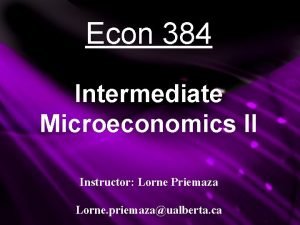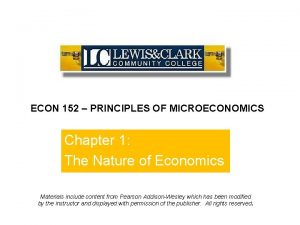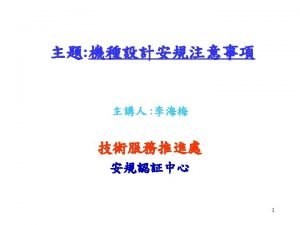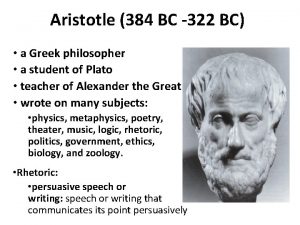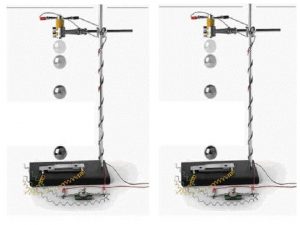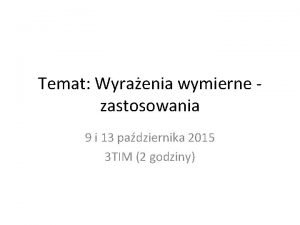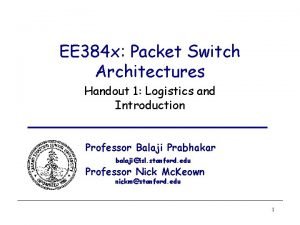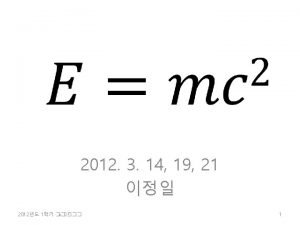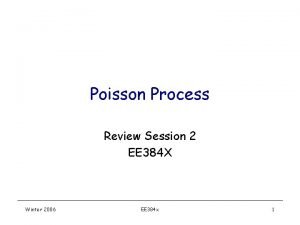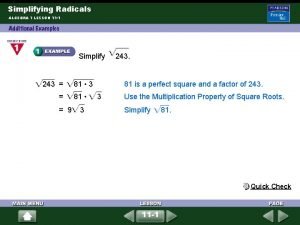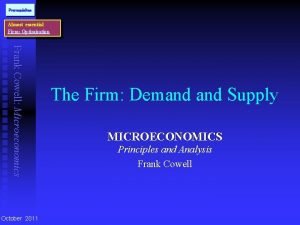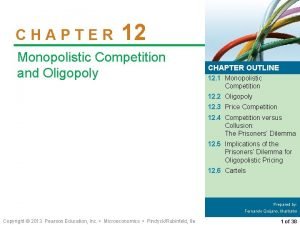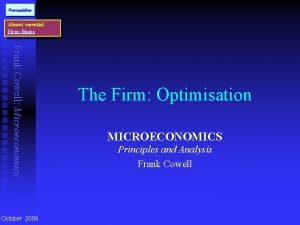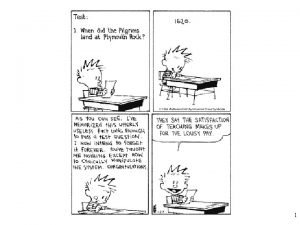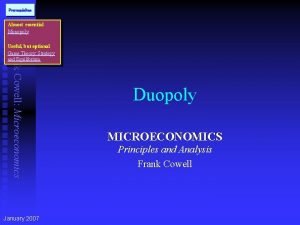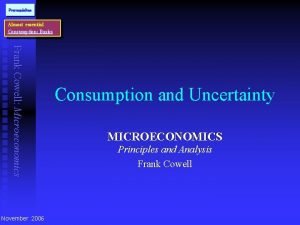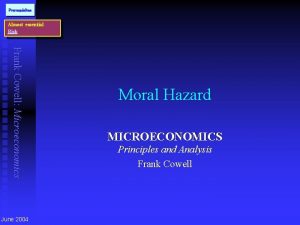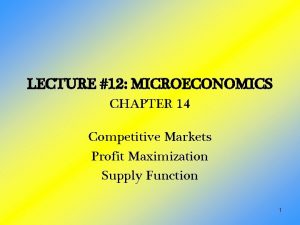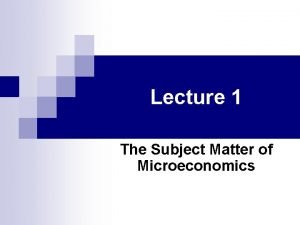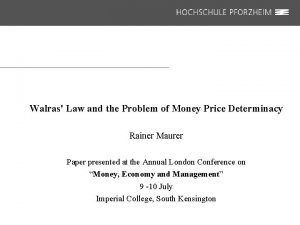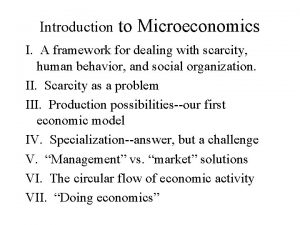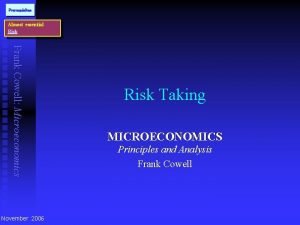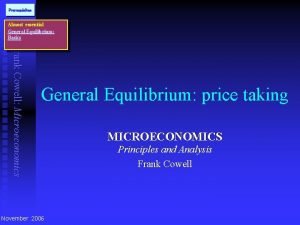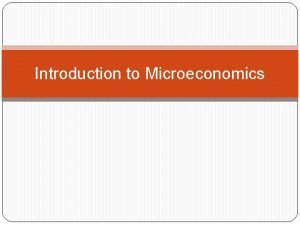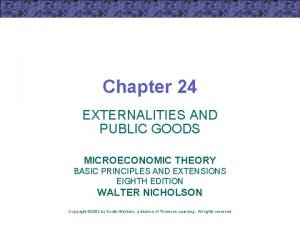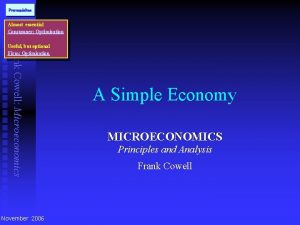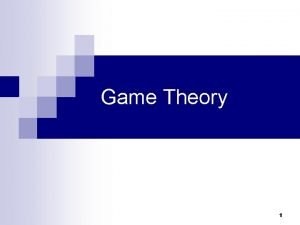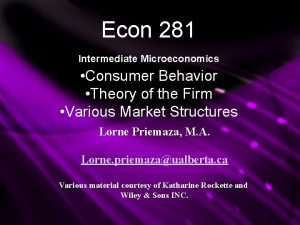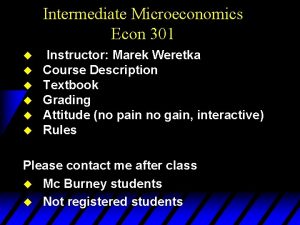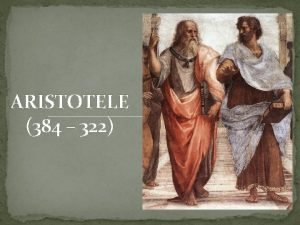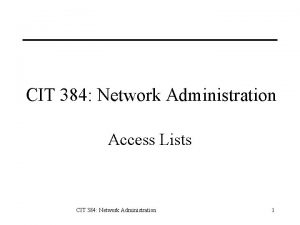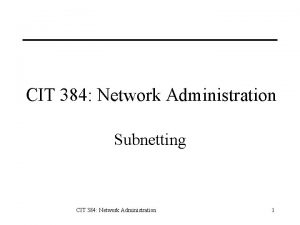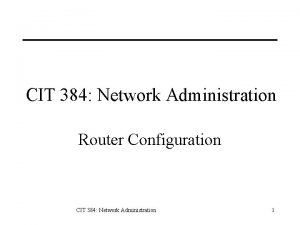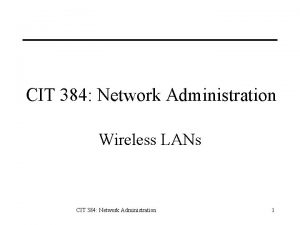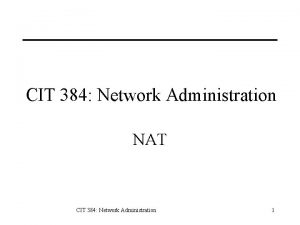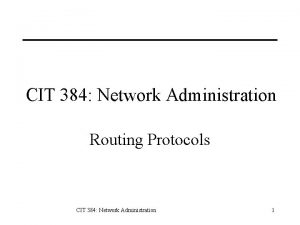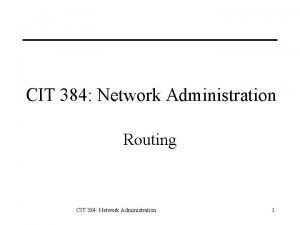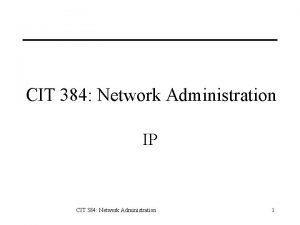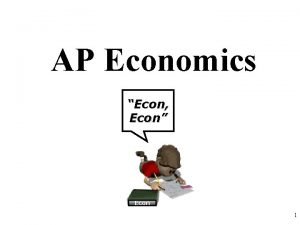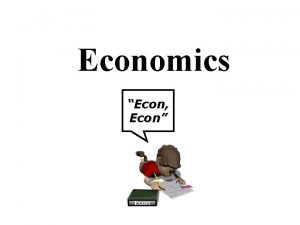Econ 384 Intermediate Microeconomics II Lorne Priemaza M




















































- Slides: 52

Econ 384 Intermediate Microeconomics II Lorne Priemaza, M. A. Lorne. priemaza@ualberta. ca Various material courtesy of Wiley & Sons INC.

Chapter 13 13. 1 Market Structure 13. 2 Homogeneous Oligopoly 13. 3 Dominant Firm Markets 13. 4 Oligopoly with Horizontally Differentiated Products 13. 5 Monopolistic Competition Appendix

13. 1 Market Structure Market structure depends upon two spectrums: 1) Number of firms in market 2) Product Differentiation Definition: Product Differentiation between two or more products exists when the products possess attributes that, in the minds of consumers, set the products apart from one another and make them less than perfect substitutes. Examples: Pepsi is sweeter than Coke, Brand Name batteries last longer than "generic" batteries.

13. 1 Market Structure

13. 1 Market Structure A) Perfect Competition 1) Many Firms 2) Homogeneous Products examples: Lemonade stands, fries B) Monopolistic Competition 1) Many Firms 2) Differentiated Products Examples: dry cleaning, socks, burgers

13. 1 Market Structure C) Homogeneous Products Oligopoly 1) Few Firms 2) Homogeneous Products Examples: Convenience Store, Apples D) Differentiated Products Oligopoly 1) Few Firms 2) Differentiated Products Examples: Cola, Breakfast Cereals

13. 1 Market Structure E) Dominant Firm 1) One Large Firm, many small firms 2) Homogeneous Products Examples: Ketchup, MP 3 Players F) Monopoly 1) One Firm 2) One Product Examples: Canadian Uranium, Canadian Health Insurance (government monopoly)

13. 1 Measuring Market Structure 1) Four-firm Concentration Ratio (4 CR) -Sum of the top 4 sales revenue (in percentage terms) in an industry ie 1) Internet: Shaw (50%) and Telus (50%) 4 CR = 50%+50%=100% ie 2) French Fries: New York (10%), Mc. Donalds (7%), Wendy’s (4%), Red Robin (3%) 4 CR = 10%+7%+4%+3%=24% *Note: Values are assumptions

13. 1 Measuring Market Structure 2) Herfindahl-Hirschman Index (HHI) -∑(Market Share)2 ie 1) Monopoly: HHI=1002=10, 000 ie 2) 100 Identical Firms: HHI=100(1)2=100 -HHI ranges from 0 (infinite firms) to 10, 000 (one firm) *Note that the textbook calculations are inconsistent for HHI

13. 1 Measuring Market Structure -TYPICALLY: -Industries closer to perfect competition or monopolistic competition have low 4 CR’s and HHI’s -Oligopolies have intermediate 4 CR’s and HHI’s -Industries closer to monopolies and dominant firms have high 4 CR’s and HHI’s -This is a GENERALIZATION (there are deviations)

13. 1 Measuring Market Structure

13. 2 Homogeneous Oligopoly In perfect competition, each firm can ignore all other firms. Oligopoly markets feature COMPETITIVE INDERDEPENDENCE – firm A’s decisions affect the profits of other firms. ex) if Firm A overproduces, price falls and Firm B’s profits decrease How does this close interdependence affect firm behavior?

Cournot Oligopoly Assumptions • Firms set outputs (quantities)* • Homogeneous Products • Simultaneous • Non-cooperative *Definition: In a Cournot game, each firm sets its output (quantity) taking as given the output level of its competitor(s), so as to maximize profits. Price adjusts according to demand. 13 Chapter Thirteen

Simultaneously vs. Non-cooperatively Definition: Firms act simultaneously if each firm makes its strategic decision at the same time, without prior observation of the other firm's decision. Definition: Firms act non-cooperatively if they set strategy independently, without colluding with the other firm in any way 14 Chapter Thirteen

Residual Demand Definition: The relationship between the price charged by firm i and the demand firm i faces is firm is residual demand In other words, the residual demand of firm i is the market demand minus the amount of demand fulfilled by other firms in the market: Q 1 = Q – Q 2; firms are QUANTITY TAKERS (v. price takers in Perfect Competition) Note: We will initially assume only 2 firms, a 15 DUOPOLY Chapter Thirteen

Residual Demand Price 10 units Residual Marginal Revenue when q 2 = 10 Residual Demand when q 2 = 10 MC Demand 0 q 1* Quantity Best response to q 2 = 10 16

Best Response/Reaction Function Best Response. The point where (residual) marginal revenue equals marginal cost gives ONE best response of firm i to its rival's action. Reaction Function. The graph of all possible best responses to rival actions 17 Chapter Thirteen

Reaction Functions q 2 Reaction Function of Firm 1 q 2* 0 • q 1* Reaction Function of Firm 2 q 1 Chapter Thirteen 18

Cournot Equilibrium: No firm has an incentive to deviate in equilibrium; each firm is maximizing profits given its rival's output Each Firm’s output is a BEST RESPONSE to each other firm’s output. 19 Chapter Thirteen

Cournot Equilibrium Example P = 100 - Q 1 - Q 2 MC = AC = 10 What is firm 1's profit-maximizing output when firm 2 produces 50? Residual demand: P = (100 - Q 1) – 50 = 50 - Q 1 TR=PQ= 50 Q 1 - Q 12 MR 50 = ∂TR/ ∂Q 1 = 50 - 2 Q 1 Since profit is maximized when MR=MC, MR 50 = MC 50 - 2 Q 1 = 10 40 = 2 Q 20 = Q 20 Chapter Thirteen

Cournot Equilibrium Example P = 100 - Q 1 - Q 2 MC = AC = 10 What is the equation of firm 1's reaction function? Residual demand: P = (100 - Q 2) - Q 1 TR= PQ 1 = 100 Q 1 - Q 2 Q 1 - Q 12 MRr = ∂TR/ ∂Q 1 =100 - Q 2 - 2 Q 1 MRr = MC 100 - Q 2 - 2 Q 1 = 10 Q 1 r = 45 - Q 2/2 firm 1's reaction function • Similarly, Q 2 r = 45 - Q 1/2 21

Cournot Equilibrium Example P = 100 - Q 1 - Q 2 Q 1 r = 45 - Q 2/2 MC = AC = 10 Q 2 r = 45 - Q 1/2 Calculate the Cournot equilibrium. Q 1 = 45 - Q 2/2 Q 1 = 45 - (45 - Q 1/2)/2 Q 1* = 30 Q 2* = 30 P = 100 - Q 1 - Q 2 = 100 - 30 = 40 1* = 2* = TR – TC = (P-MC)Q* 1* = 2* = (40 -10)(30) = 900 Chapter Thirteen 22

Cournot Solving Steps 1) 2) 3) 4) 5) Calculate Residual Demand Calculate (residual) MR MR=MC to find reaction functions Use reaction functions to solve for Q’s Use Q’s to solve for P -Remember that Q 1+Q 2=QM 6) Solve for 7) Summarize 23 Chapter Thirteen

How do firms achieve Cournot Equilibria? q 2 1) Each firm can calculate Reaction Functions 2) Firm 2 will never produce over A 3) Knowing this, Firm 1 will never produce under B 4) Knowing this, Firm 2 will never produce over C 5) This reasoning continues until point Z A • C q 2* Z Reaction Function of Firm 2 0 B q 1* q 1 Chapter Thirteen 24

Cournot vs. Monopoly vs. PC Since Pcournot > MC, Cournot prices are higher than perfect competition prices Ø Cournot firms have market power BUT, a Cournot market produces more than a Monopoly, and at a lower price. Each firm’s pursuit of individual self-interest does not typically maximize the industry’s profits. Ø Each firm wishes the other would decrease quantity ØMonopoly profits are possible if firms collude 25 (which is illegal)

PC vs. Cournot vs. Monopoly Consider the following outcomes using our above example of P=100 -Q: The outcome changes greatly with number of firms. 26

Cournot Equilibrium, Many Firms P = a-b. Q MC = c N identical firms Find Cournot Equilibrium Quantity Residual demand P = a-b(Q 1 + Qother) TR = PQ = a. Q 1 -b. Q 12 – b. Qother. Q 1 MR = ∂TR/ ∂Q = a-2 b. Q 1 – b. Qother Since profit is maximized when MR=MC, MR = MC a-2 b. Q 1 – b. Qother = c Q 1=(a-c)/2 b – (1/2)Qother Since Qother = (N-1) Q 1, Q 1=(a-c)/2 b – (1/2)[(N-1)Q 1] Since Q 1=Q* 27

Cournot Equilibrium, Many Firms P = a-b. Q MC = c N identical firms Find Cournot Equilibrium Market Price Since there are N firms, 28

Cournot Solving Steps Multi-Firm 1) Calculate Residual Demand 2) Calculate (residual) MR 3) MR=MC to find reaction functions New 3 b) Remember that Qother = (N-1) Q 1 4) Use reaction functions to solve for Q’s 5) Use Q to solve for P -Remember that ∑Qi=QM 6) Solve for 7) Summarize 29 Chapter Thirteen

Outcome comparisons Given the relationship P=a-b. Q and MC=c, 30 Chapter Thirteen

13. 2 Bertrand Oligopoly (Homogeneous Products) Cournot Oligopoly –Firms compete on QUANTITY Bertrand Oligopoly –Firms compete on PRICES -Goods must be homogeneous/identical -A firm’s residual demand depends on the other firm’s price: Ø Zero demand at prices higher than the other firm Ø Market demand at prices lower than the other firm

Bertrand Oligopoly (homogeneous) Assumptions: • Firms set price* • Homogeneous product • Simultaneous • Non-cooperative *Definition: In a Bertrand oligopoly, each firm sets its price, taking as given the price(s) set by other firm(s), so as to maximize profits. 32

Residual Demand Curve – Price Setting Price Market Demand P 2 • Firm 1’s Residual Demand Curve Quantity 0 33 Chapter Thirteen

13. 2 Bertrand Oligopoly (Homogeneous Products) Ø Firm A must undercut firm B’s price to sell anything Ø This will force firm B to undercut Firm A. . . Ø This will continue until neither firm can decrease price further, P=MC Ø The Perfect Competition Result!

Bertrand Equilibrium Example P = 100 - QT MC = AC = 10 What is the Bertrand Equilibrium? P = MC=10 P = 100 – QT 10 = 100 – QT 90 = QT ∏=TR-TC ∏=(P-MC)Q ∏=(10 -10)90 = 0 35

Bertrand vs. Cournot – Long-Run Competition (Firms choose output capacity) Bertrand – Short-Run Competition (Firms have excess output) ---------------------------------Cournot – Firms can quickly adjust their price, so price competition is useless Bertrand – Firms can only slowly adjust price, so firms believe a price cut can temporarily increase profits

Stackelberg Oligopoly Stackelberg model of oligopoly is a situation in which one firm acts as a quantity leader, choosing its quantity first, with all other firms acting as followers. Call the first mover the “leader” and the second mover the “follower”. The second firm is in the same situation as a Cournot firm: it takes the leader’s output as given and maximizes profits accordingly, using its residual demand. The second firm’s behavior can, then, be summarized by a 37 Cournot reaction function.

Stackelberg Leader Choice The Stackelberg leader knows the follower’s reaction function, and can use that to choose its production: P = 100 - QL - QF MC = AC = 10 What is the equation of the follower’s reaction function? Residual demand: P = (100 - QL) - QF TR= PQF = 100 QF - QF QL - QF 2 MRFr = ∂TR/ ∂Q 1 =100 - QL - 2 QF MRFr = MC 100 - QL - 2 QF = 10 QFr = 45 - QL/2 follower’s reaction function 38

Stackelberg Leader Choice P = 100 - QL - QF QFr = 45 - QL/2 MC = AC = 10 Calculate the Stackelberg equilibrium. P = 100 - QL - QF = 100 - QL – (45 - QL/2 ) P = 55 – QL/2 TR= PQL = 55 QL – QL 2/2 MRL = ∂TR/ ∂QL = 55 – QL MRL = MC 55 – QL = 10 QL = 45 39 Chapter Thirteen

Stackelberg Leader Choice P = 100 - QL - QF QFr = 45 - QL/2 MC = AC = 10 QL = 45 Continue Calculating the Stackelberg equilibrium. QFr = 45 - QL/2 = 45 - 45/2 QFr = 22. 5 P = 100 - QL - QF = 100 - 45 – 22. 5 = 32. 5 L* = TR – TC = (P-MC)QL* = (32. 5 -10)45 = 1, 012. 5 F* = TR – TC = (P-MC)QF* = (32. 5 -10)22. 5 = 506. 25 40 Chapter Thirteen

Stackelberg Leader Choice With a Stackelberg leader, price is $32. 50, with the leader producing 45 units for a profit of $1, 012. 50 and the following producing 22. 5 units for a profit of $506. 25. Notice that: 1) Price is lower than the Cournot equilibrium 2) Leader profits are higher than the cournot equilibrium 3) Follower profits are lower than the Cournot equilibrium 41 Ø There is an advantage to moving first

Stackelberg Solving Steps 1) 2) 3) 4) 5) Calculate Leader’s Residual Demand Calculate Leaders (residual) MR Leader’s MR=MC to find QL Use QL to solve for QF Use Q’s to solve for P -Remember that QL+QF=QM 1) Solve for ’s 2) Summarize 42 Chapter Thirteen

13. 3 Dominant Firm Model The dominant firm model features: 1) A single company with an overwhelming market share (a dominant firm), D 2) many small producers (competitive fringe), each of whom has a small market share, F The dominant firm faces market demand, and residual demand that takes into account the competitive fringe’s supply:

Dominant Firm The dominant firm’s residual demand (DR) is market demand minus competitive fringe supply (in terms of Q) 44

Dominant Firm Example P = 100 - QT MCD = AC = 10 SF: P =10+QF or QF =P - 10 What is the equation of the Dominant Firm’s Residual Demand? QR = QT – QF QR = 100 -P – (P-10) QR = 110 -2 P P = 55 -QR/2 45

Dominant Firm Example P = 100 - QT MCD = AC = 10 SF: P =10+QF or QF =P - 10 QR = 90 -2 P (P = 55 -QR/2) Calculate Dominant Firm Quantities and Price TRDR = PQD = 55 QD-QD 2/2 MRL = ∂TR/ ∂QL = 55 – QD MRL = MC 55 – QD = 10 QD = 45 P = 55 -QR/2 P = 55 -45/2 = 32. 5 46

Dominant Firm Example P = 100 - QT MCD = AC = 10 SF: P =10+QF or QF =P - 10 QR = 90 -2 P (P = 55 -QR/2) Calculate and check Competitive Fringe Quantities SF: P =10+QF 32. 5 = 10+QF QF = 22. 5 QT = QD + QF QT = 45 + 22. 5 = 67. 5 P = 100 – QT 32. 5 = 100 – 67. 5 = 32. 5 47

Dominant Firm Example P = 100 - QT SF: P =10+QF or QF =P - 10 MCD = AC = 10 QR = 90 -2 P (P = 55 -QR/2) QF = 22. 5, QD = 45, P=32. 5 Calculate market share and dominant firm profit D: Market Share = QD/ QT = 45/67. 5*100 = 66. 6% F: Market Share = QD/ QT = 22. 5/67. 5*100 = 33. 3% D* = TR – TC = (P-MC)QD* = (32. 5 -10)45 = 1, 012. 5 At a price of $32. 50, the dominant firm produces 45 units for a profit of $1, 012. 50, and fringe 48 firms produce 22. 5 total.

Dominant Firm Solving Steps 1) 2) 3) 4) 5) Calculate Dominant Firm`s Residual Demand Calculate Dominant Firm`s (residual) MR Leader’s MR=MC to find QD Use QD to solve for P Use P to solve for QF -Remember that QD+QF=QM 1) Solve for and Market Share 2) Summarize 49 Chapter Thirteen

Aside: Calculating SF Recall: Ø A competitive firm’s supply comes from its MC curve Ø Identical firms supply can be summed (through q) Fringe Firm: MC=5+20 q, 40 firms Calculate Fringe Supply MC=5+20 q q=(P-5)/20 QF=40(P-5)/20 QF=2 P-10 50

Growing Fringe: As the size of the fringe grows, the price, and the production and profits of the dominant firm decreases (next slide): There is therefore an incentive for the dominant firm to practice limit pricing (illegal in Canada): Limit Pricing – a strategy whereby the dominant firm keeps its price below the level that maximizes its current profit in order to reduce the rate of expansion by the fringe 51

52
 Lorne priemaza
Lorne priemaza Lorne priemaza
Lorne priemaza Econ 152
Econ 152 Intermediate microeconomics notes
Intermediate microeconomics notes Intermediate microeconomics lecture notes
Intermediate microeconomics lecture notes Lorne trottier
Lorne trottier Lorne park elementary school
Lorne park elementary school Lorne park secondary school
Lorne park secondary school Dr lorne schlecht
Dr lorne schlecht Fowx
Fowx 384 bce
384 bce 384 bc
384 bc 384 bc
384 bc 384 bce
384 bce 384 bce
384 bce Aristote 384-322
Aristote 384-322 Długość pewnej linii kolejowej to około 384 km
Długość pewnej linii kolejowej to około 384 km 384 x 1/2
384 x 1/2 Nació en macedonia en el 384 a. c.
Nació en macedonia en el 384 a. c. 384 bc
384 bc 384 x 52
384 x 52 Simplify each radical expression
Simplify each radical expression 384-322
384-322 384 bce
384 bce 384 bc
384 bc Cowell microeconomics
Cowell microeconomics Branches of economics
Branches of economics Oligopoly model
Oligopoly model The firm basics
The firm basics Ap microeconomics unit 1 basic economic concepts
Ap microeconomics unit 1 basic economic concepts Microeconomics examples
Microeconomics examples Cowell microeconomics
Cowell microeconomics Microeconomics
Microeconomics Microeconomics vs macroeconomics venn diagram
Microeconomics vs macroeconomics venn diagram Cowell microeconomics
Cowell microeconomics Microeconomics chapter 12
Microeconomics chapter 12 Economics michael parkin 13th edition
Economics michael parkin 13th edition Circulair flow marketing
Circulair flow marketing Almost essential
Almost essential Microeconomics
Microeconomics What is the subject matter of microeconomics
What is the subject matter of microeconomics Walras's law
Walras's law Microeconomics ia
Microeconomics ia Cowell microeconomics
Cowell microeconomics Venn diagram of macroeconomics and microeconomics
Venn diagram of macroeconomics and microeconomics Almost essential
Almost essential Uses of microeconomics
Uses of microeconomics Significance of microeconomics
Significance of microeconomics Pure public good
Pure public good Rent principles of microeconomics
Rent principles of microeconomics Almost essential
Almost essential Game theory microeconomics
Game theory microeconomics Objective of microeconomics
Objective of microeconomics

